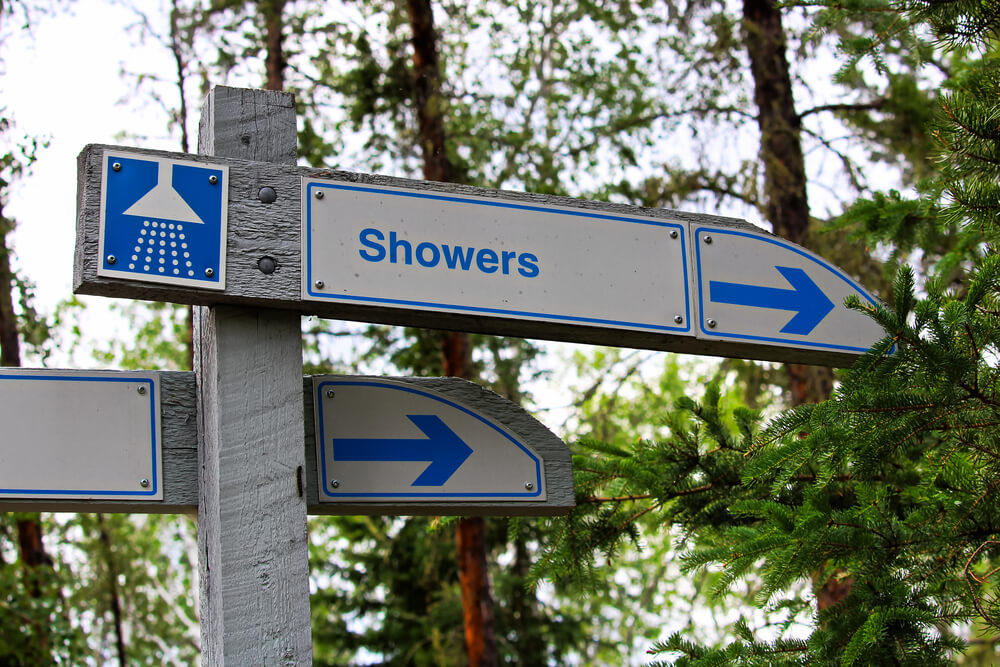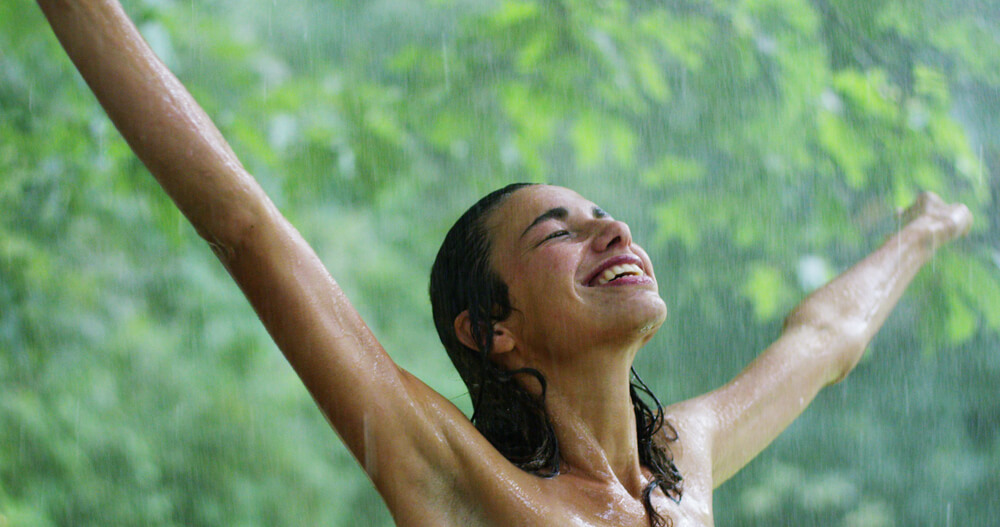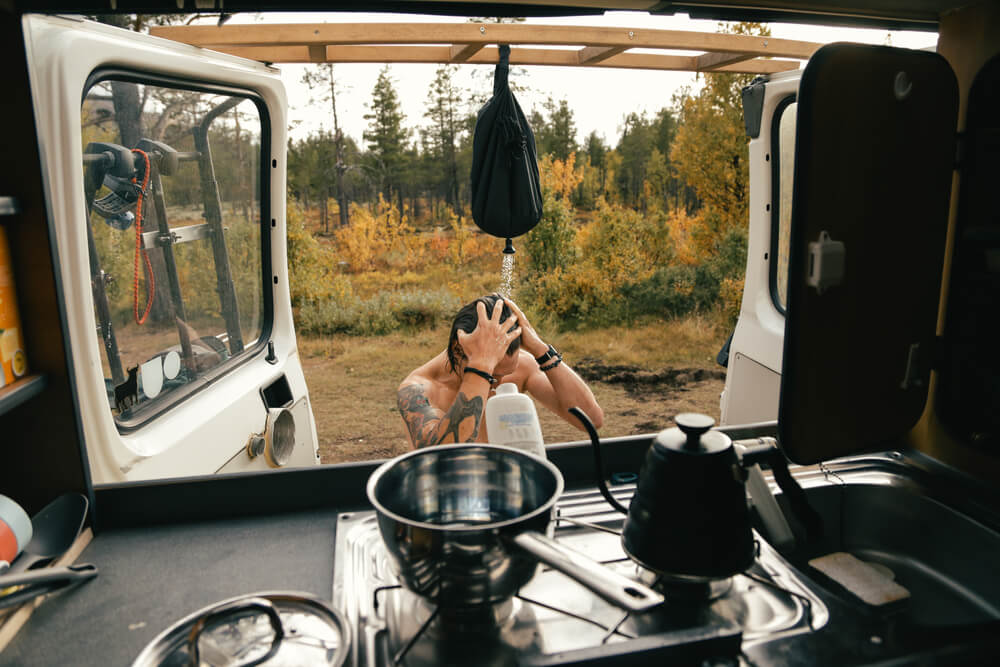Camping trips can be rewarding, but exploring the great outdoors can get you dirty. While you cannot take a traditional shower, there are plenty of ways to get clean.
More...

Table of Contents
Where to Find Showers When Camping?
If you want to go camping and are worried about showering, try to find a private campground. These places generally have showers that you can use. However, they cost more to stay at than somewhere in the middle of the woods.
U.S. Army Corps of Engineers campgrounds often have bathhouses as well. Finding these campsites can prove challenging, and you will need to make reservations beforehand. You’ll need to pay a fee to stay there, but they are clean and well maintained.
Some campgrounds will even let you use the shower without staying there. Likely, they will charge you for shower usage. Make sure to check with the headquarters to see if they offer this option and pay the fee.
If you have a membership at a gym or the YMCA, you can take a shower at that location. Many of these places let you bring one other person to save you money on multiple memberships.
Some places that always have free showers are public beaches and pools. Not all have private showers in the bathrooms, but you could rinse off and even use some soap over a bathing suit.

Bathing in Nature
Camping in nature means you need to respect it. As such, you should shower at a distance of at least 200 feet from nearby water sources. Also, you should keep your distance from your campsite to prevent water from flooding the surrounding soil.
Likewise, use biodegradable and eco-friendly hygienic products to avoid contamination of the environment. Keep in mind that a portable shower does not connect to a constant water source, so be cognizant of water conservation when showering.
The size of the water reservoir (tank capacity) in a portable shower typically varies from 2.5-5 gallons. If you opt for a DIY design, you could construct a water reservoir that has a higher capacity.
Here are some useful things to keep in mind when showering at a campsite:
- Wear waterproof clothing. Natural materials that hold moisture can serve as breeding grounds for bacteria. Even sweat can trap bacteria.
- When showering on a campsite, you should wear flip-flops or bring a rubber mat. That way, you can avoid stepping on dirt or anything harmful while showering.
- You could use bio-wipes to remove any dirt if you cannot shower.
- Dry yourself using a microfiber towel. Microfiber is easier to pack than cotton towels, so you can readily transport it to your campsite.
- Bring your dental hygiene products to get your whole body clean at once.
Portable Shower Kits
Portable shower kits are some of the most popular forms of outdoor bathing. Most come with bags that you fill with water. They rely on gravity to pour water onto you. Others feature traditional showerheads with hoses that pump water from a bucket.
There are many types of shower kits. If you would prefer something more similar to the shower you would have at home, consider a battery- or electricity-powered portable shower kit.
Electric
As the name suggests, this kind of portable shower is powered by an electrical outlet. You can use a power outlet if you camp at a campground that has integrated utilities. Some also work with the power from your car.
If you aren’t afraid of using your car battery, you can get this one. They provide warm water and can pressurize the water if they come with a pump.
Battery
Battery-powered shower kits often use four D batteries and a motor to power a pump that goes into a bucket full of water. It pumps water into a shower nozzle attached to a hose. These kits can heat the water reservoir and maintain constant water pressure.
A good option to consider with a battery-operated shower is rechargeable batteries with a solar-powered battery recharger. Also, get a collapsible bucket to keep the kit more compact.
Gas
Gas-powered shower kits utilize propane gas to heat and maintain the temperature of the water reservoir. The most beneficial aspect of gas-powered shower kits is that it’s one of the models that heat the water the fastest.
These systems use more parts than the others, including a battery and pump. Nevertheless, they heat the water almost instantly, as you would in your shower at home.
Solar
One of the cheapest portable showers is solar shower kits. You fill the water reservoir bag with water, place it in the sun for several hours, and suspend it for warm water. If you do not have time, keep the bag in the back window of your car or warm it on the stove for a hot shower.
These showers are environmentally friendly, inaccessible, and convenient. However, they rely on gravity, do not generate water pressure, and take a while to work.
Foot-Pump
A foot-pump shower can “defy gravity” in a way. You can prop it on any surface and use a pump to pressurize the water in the bag. Many have hoses attached to showerheads that you can adjust to your height.
By stepping on the foot pump, you can have sufficient water pressure and free reign of your hands. They do not use batteries, which makes them cheaper. You will need to place the bag in the sun for warmth, so it is not the most time-efficient.
Multi-Use System
A multi-use system shower combines a water purifier with a portable shower. They use a filter and two black bags that let gravity purify the water. The dark color absorbs heat as well to warm the water.
Roof Rack
When car camping, you can attach a shower kit to your roof rack. These kits come with water tubes that go on your car’s roof racks. You can fill up the water reservoir before driving and let the sun warm it up during your travels.
It can even get somewhat pressurized by dropping from the roof to the shower handle.
Hot-Water Car Kit Shower
A hot-water car kit shower is one of the more expensive options. A hot-water car kit features a water reservoir, pump, and showerhead nozzle. The kit connects to the vehicle’s engine compartment, which allows the water to be heated by outflow heat while running.
Likewise, the water reservoir is insulated. This allows heated water to maintain a suitable temperature for showering. The water reservoir holds a separate compartmentalized tank with cold water, letting you use hot and cold water.
A hot-water car kit requires that you shower right outside of the vehicle; therefore, pair a hot-water car kit with a privacy tent. When you are ready to shower, adjust the temperature knobs on the water reservoir.
DIY Shower
A Do-It-Yourself (DIY) shower can take many forms, although most DIY showers use gravity:
- Clean a two-liter soda bottle. You can use other similarly sized bottles as well.
- Use a small nail to poke holes in the cap. The number of holes depends on the size of the nail. Try to arrange them in a manner that resembles a showerhead.
- Fill the cleaned bottle with warm water. You can heat water over a campfire and let it cool to a lukewarm temperature to avoid degrading the bottle, especially if it’s plastic.
- Screw the cap back onto the bottle.
- Cover the cap with your hand as you invert the bottle. Prop it on a tree branch, the top of your car, or some other surface that will hold it in place as you shower beneath it.
- Stand under the bottle, let go of the cap, and let gravity do the trick as you bathe under it.
If you have some extra time to prepare before camping, you can try this DIY shower. Take some ABS pipe and cut it long enough to affix to the roof of your car. Get a spigot or showerhead plug-in for one end of the pipe.
Use a submersible water pump that you can place in a water reservoir. Get a hose that’s slightly longer than the height of your car. Connect one end to the pipe and the other to the pump.
Fill the reservoir with warm water or let it heat in the sun for a few hours. Then, submerge the pump in it and turn it on to the desired pressure setting.
As the pump runs, pressurized water will run through the hose and pipe, then out the showerhead. If you have some extra time and money, you can use a solar heater that uses photovoltaic panels to keep the water at an ideal temperature.

How to Shower When Camping?
If you have never used a portable shower before, you might feel nervous about bathing outdoors. Follow these steps when bathing outdoors:
- Prop the shower kit on a hard surface like the roof of your car or rock. Avoid surfaces covered in sand or soil. The water will turn it into mud, so it will only get you dirty.
- If you are worried about other people seeing you naked, you can wear a bathing suit and flip-flops. For more thorough cleaning, you could always wait until it gets dark outside.
- Some shower kits come with hooks and straps for easy hanging. If yours does not, you can use a vehicle hatchback, roof rack, or rope to hoist it up. Another option would be to prop it between a vertically angled tree branch and trunk.
- You will need to turn the water on and off frequently. Once you get wet, turn the water off to soap up. Then, turn it on to rinse off. Most water reservoirs do not have a large enough capacity to run continuously.
- If you want, you can get a shower enclosure for extra privacy. These can hold the water overhead, and you won’t have to worry about someone watching you.
If All Else Fails, There Are Other Options to Get Clean
If you forget to bring along the equipment to take a shower and experience difficulty in locating and using dedicated shower facilities, there are other options to consider for getting clean.
Water Source
Before, we recommended not bathing near a natural water source. However, that only holds if you plan on using soapy products. If you only want to rinse off natural oils and dirt, you can bathe in a lake, stream, or waterfall.
You may even find biodegradable products that you can use in surface water. Use a washcloth and a small amount of soap to clean yourself. Avoid using too much of the product to minimize contamination.
Sponge and Bucket
A tried and true method to get clean is with a sponge and bucket. Fill the bucket with water and add some soap. Take the sponge, dip it in soapy water, and scrub off the dirt.
To clean your hair, you can dunk your head in some clean water. Fill a bucket with some freshwater as well.
If you use a natural water source, get at least 200 feet away before proceeding. Lather your hair with shampoo and rinse off with the bucket. If you want to use a conditioner, you would also rinse it with the bucket.
If you have a camp stove, you can heat the water there and pour some on a washcloth you’ve covered with soap. This option will be more comfortable than cold water, but either should get you clean without running water.
Baby Wipes & Dry Shampoo
While not as effective as a shower, baby wipes and dry shampoo can tide you over. Use the wipes to remove some dirt and oils from your skin. Dry shampoo won’t remove any dirt, but it can keep down the grease for a few days.
Moist towelettes also work. Some of these are designed for camping, but these are more expensive. Look for ones that are moistened with soap rather than alcohol to clean up. While alcohol wipes are helpful to have for injuries, they may irritate sensitive skin.
Makeup remover wipes are designed for facial skin. You can even find some made for sensitive skin. These should help you retain moisture better than baby wipes. However, baby wipes tend to cost less than makeup ones.
No-Rinse Soap
Some mild cleansers exist that you don’t need to wash off. These can remove dirt, sweat, and dead skin while leaving in some moisture. All you have to do is dispense the soap, rub it on your skin, and wipe it with a damp cloth. Many of these formulas double as shampoos.
Products like micellar water can remove dirt and don’t need to be removed. While micellar water is designed to take off makeup, you can gently cleanse your skin with it.
Where possible, look for no-rinse products made with natural ingredients. Dr. Bronner’s soap works in this manner. You rub it on and wipe it with a towel.
Nevertheless, you will need to wash away from natural water sources as the ingredients can harm marine life.
Public Restrooms
While not the most comfortable option, you can freshen up in most public restrooms. Visit a fast-food restaurant or gas station and head to the bathroom. Splash water on your skin and use the soap to clean up a little.
You can use paper towels to wipe down other body parts as well. If you have a washcloth, you can rinse it in the sink to wipe it off while in a stall.
Waterless Washcloth
Waterless washcloths are usually plastic or microfiber towels with a waffle weave design. You scrub your skin with them to remove some dirt. The grime gets trapped in the fibers, so you can get clean without water. You will want to wash them every few uses to get off any bacteria.
Share an Earth “Shower”
Whenever it rains, the planet gets a shower of its own. Why not share? If you are desperate for a shower, you can go out in the rain to wash down. It’s probably the most continuous stream of water you will get outdoors unless you bathe in a waterfall.
Takeaway Thoughts
Now that you’ve learned how to shower when camping, you can use some of these tips on your next trip to the forest.
Many campgrounds offer full showers when you pay for admission. If you aren’t staying at a camping resort, you can usually pay a small fee to clean up there. Even public showers at gyms, pools, or beaches will work.
For those sticking to the outdoors, you can easily buy or make a portable shower kit. Look for one that fits your budget, space, and comfort levels.
If you run out of time to prepare a shower kit and need to get clean, you aren’t out of luck. Bathe in a stream, use some wipes, or fill a bucket with soapy water to tide you over until your next shower.
- Are Merrell Shoes Good? – An Unbiased Review of Merrell Footwear - December 9, 2023
- Where Are Merrell Shoes Made? - December 9, 2023
- Camping in 40-degree Weather: Tips and Tricks - September 25, 2023


![Why Your Campfire Smokes So Much? [Quick Answers You Should Know] Why Your Campfire Smokes So Much? [Quick Answers You Should Know]](https://grandcircletrails.com/wp-content/uploads/2021/09/Why-Your-Campfire-Smokes-So-Much-1-150x150.jpg)
![Are Mittens Warmer Than Gloves? [Quick Answers You Should Know] Are Mittens Warmer Than Gloves? [Quick Answers You Should Know]](https://grandcircletrails.com/wp-content/uploads/2021/11/hiking-glooves-1-150x150.jpg)
![Are Hammocks Better Than Beds? [Quick Answers & Questions] Are Hammocks Better Than Beds? [Quick Answers & Questions]](https://grandcircletrails.com/wp-content/uploads/2021/12/Are-Hammocks-Better-Than-Beds-1-150x150.jpg)
![Camping Blankets Instead of Sleeping Bags [Quick Guide] Camping Blankets Instead of Sleeping Bags [Quick Guide]](https://grandcircletrails.com/wp-content/uploads/2022/02/camping-blanket-1-150x150.jpg)

![How to Fluff Down Jacket? [Quick Tips For You] How to Fluff Down Jacket? [Quick Tips For You]](https://grandcircletrails.com/wp-content/uploads/2022/01/How-to-Fluff-Down-Jacket-1-150x150.jpg)